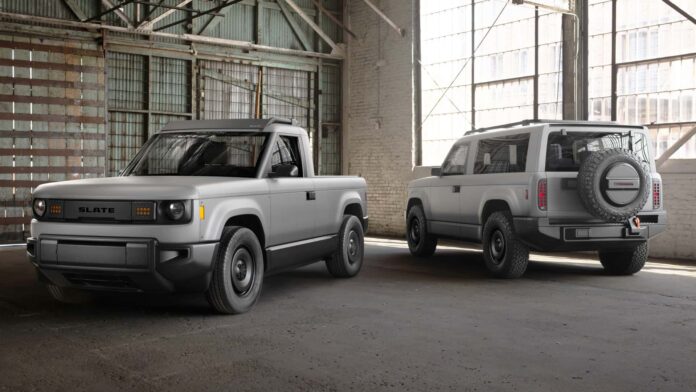Asking how Slate was able to price its electric truck so cheaply may sound like a “no-duh” question. It’s a bit like marveling at how Spirit Airlines is able to sell flights for 50 bucks. The answer is obvious, and in some ways not all that profound: Give people the absolute bare minimum, and charge extra for everything else.
In Spirit’s case, that means slapping on fees for carry-ons and printing out your boarding pass. Slate, a new auto startup that revealed itself last week, plans to sell a truck that goes, stops, keeps you dry and, well… that’s about it. Everything else is extra.
The difference is that while budget airlines have been around for decades, affordable, no-frills cars are practically nonexistent today. Especially electric ones. And especially ones as radically simplified as the Slate, a two-door pickup truck that targets an entry price of under $20,000 after federal EV rebates.
Plus, there’s a lot more to Slate’s secret sauce than just tossing your power mirrors and other gadgets in the trash, top executives told InsideEVs.
The Slate Truck: Why Is It So Cheap?
Hitting that affordable price point—around $27,000 before incentives—started with a mindset shift around what people actually need in a car, Slate CEO Chris Barman said.
“We’ve challenged everything around making a vehicle, in making sure that we understood whether it should be part of the equation or not,” she said.
Photo by: Slate
That thinking led to a truck that sounds almost comically bare-bones in 2025. The Slate truck arrives late next year with no radio, no speakers, no touchscreen, no fancy automated-driving features, hand-crank windows and a single color: gray. Stripping out everything that’s not strictly necessary for transportation and safety helped the company produce the everyman EV that’s historically eluded America’s car market.
As Barman put it in a promotional video: “We took out everything that wasn’t a car.”
Tesla has talked up a $25,000 car in the past, but that project stalled out in favor of Elon Musk’s robotaxi dreams. Other electric newcomers like Lucid and Rivian opened up shop with pricey, fully-loaded models, the plan being to bring costs down over time as they scale up. That journey is slow-going.
Photo by: Slate
Slate decided to flip the script by delivering a blank canvas that people can customize as they please through a vast catalog of accessories. That includes DIY-friendly stereo systems, interior finishes and even a bolt-on SUV kit, all of which buyers can order to their homes or have professionally installed.
“You’ve seen all of the others start on the high end and force the option content,” said Eric Keipper, the carmaker’s head of engineering. “So it’s our choice to start at the other end and build it up.”
Slate’s Radically Simplified Manufacturing And Operations
There are other, less obvious ways that Slate slashed the cost of manufacturing and development by doing things differently. It opted to make the truck’s exterior out of molded plastic, which Barman said saves costs on multiple fronts. First off, injection molding is cheaper than the conventional method of stamping sheets of metal into body panels.
Second, since the plastic is colored gray all the way through, it doesn’t need to be painted. That eliminates the roughly $350 million up-front investment required for a paint shop and a “very finicky and expensive operation,” she said. Instead, Slate will sell customers vinyl wrap kits in any color.
“Coming in at this level of the market, you have to be very focused on your cost and mindful of that,” Barman said. “Not only the cost of the vehicle, but the cost of your operation.”
Photo by: Slate
By omitting an infotainment system, Slate doesn’t need you to pay for it, sure. But it also doesn’t need to spend time and money developing the software that goes into it.
And by having its factory spit out a single, uniform variant that buyers can trick out later on, the company aims to cut a lot of complexity out of its manufacturing process. It just needs to get very good at churning out the exact same vehicle over and over again. That will come in handy given that Slate is targeting 150,000 units of annual output about a year into production—a far higher volume than any U.S. EV startup has achieved, aside from Tesla.
“Every one we build is the same,” she said. “So as we produce those vehicles at scale, then it helps to keep our costs down.”
Of course, there’s also a lot of logistical complexity in making sure all the accessories customers order end up in the right place at the right time. But Slate is betting its unconventional approach will pencil out. And it very well may, especially when you account for all the additional revenue it could rake in from owners who shell out for upgrades over time.
Photo by: Slate
Another decision that may help bring down costs: Making things in North America. Barman said the company hasn’t had to adjust any of its sourcing due to President Donald Trump’s wide-ranging tariffs, which include a 25% fee on imported car parts and huge duties on a variety of Chinese goods.
“We’re well insulated against that. Our mantra from the beginning was we wanted to source as much domestic content as we could,” Slate’s CEO said. However, it’s still looking to move sourcing for some components out of China, and there are some old-school parts it needs that simply aren’t made in the U.S. anymore. For example, Slate imports its hand-crank window systems from Brazil.
Furthermore, instead of going with cheaper lithium-iron-phosphate (LFP) batteries, which would be difficult to source while remaining compliant with the EV tax credit’s anti-China provisions, Slate chose to outfit its truck with pricier made-in-America cells. So, as long as that policy remains on the books, the truck will qualify for the $7,500 federal rebate for plug-in cars. That’s a big part of the truck’s price proposition.
Photo by: Slate
What about getting your Slate serviced if something breaks? Barman said the company will partner with “well-known and well-recognized entities that do service today” instead of building out its own brick-and-mortar locations like Tesla, Rivian and Lucid have done.
“We want to be very asset-light. We don’t feel that we need to build up that infrastructure ourselves,” she said.
Will The Slate Truck Work?
One big question is whether Slate can cross the so-called “valley of death” that has claimed so many other EV startups—the chasm between an interesting concept and a sustainable, profitable business. That requires a lot of manufacturing scale and, typically, regular cash infusions totaling in the billions. Lucid and Rivian still aren’t in the black, and Tesla only notched its first full year of profitability in 2020.
Slate argues it can. The company’s chief commercial officer, the Tesla veteran Jeremy Snyder, told The Verge that its simplified manufacturing process should allow it to “reach cash-flow positivity very shortly after start of production.”
Another unknown is whether people will embrace the Spirit Airlines of EVs, albeit one with a presumably better customer experience. Will Americans appreciate a stripped-down, highly customizable EV? Or will they feel nickel-and-dimed?
It’s hard to say, since this strategy hasn’t been attempted before. But people love to dunk on Spirit. And yet, a record 44 million people flew on the airline last year.
Got a tip about the EV world? Contact the author: Tim.Levin@InsideEVs.com


